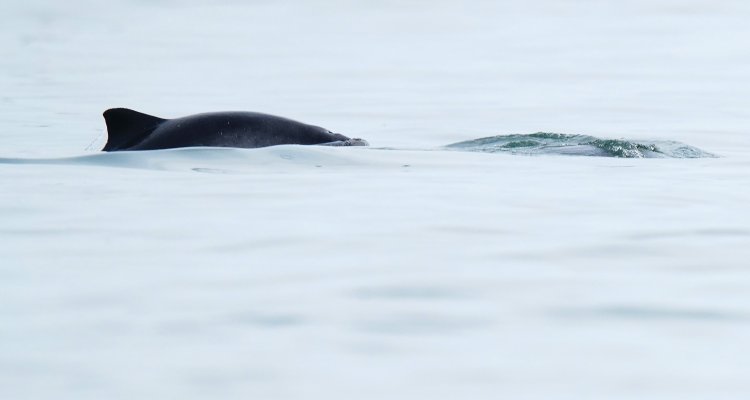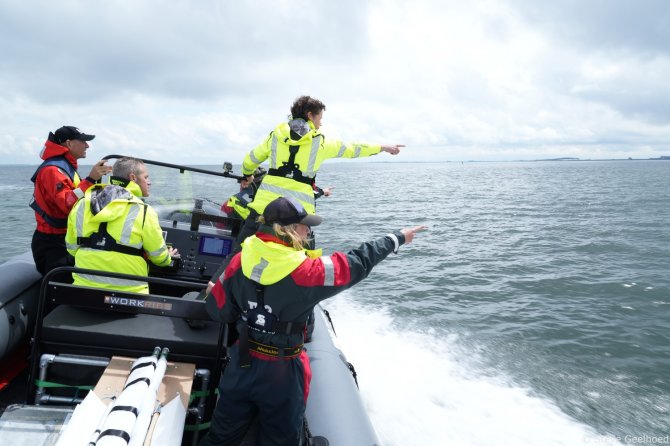
Project
Tagging harbour porpoises to gain insight into their habitat use and behaviour
The North Sea is becoming increasingly crowded and busy. This could have an impact on the population of harbour porpoises, a protected species that inhabits the North Sea, among other areas. The Netherlands is legally obligated to protect this species. By tagging harbour porpoises, we can gain more insights into their specific habitats in the North Sea and their usage of these habitats. Since the autumn of 2023, there has been ongoing research into the feasibility of tagging harbour porpoises in the Netherlands to develop more knowledge about these marine mammals.
Where in the North Sea are harbour porpoises primarily found? Do they utilise the entire North Sea? How far do they swim? Which locations do they prefer? Does the behaviour of individual harbour porpoises vary? How do harbour porpoises use human structures in the sea, such as wind farms? By tagging harbour porpoises with satellite tags, also known as telemetry, researchers can find answers to these and many other questions.
This helps us better understand how harbour porpoises use their habitats. As the North Sea is increasingly utilized by humans, the importance of this knowledge development grows. That's why the government has commissioned research on this. The research is conducted by Wageningen Marine Research (WMR) and TNO, on behalf of the Ministry of Agriculture, Nature, and Food Quality and the Offshore Wind Ecological Programme (Wozep) of Rijkswaterstaat (on behalf of the Ministry of Economic Affairs and Climate).
Feasibility
To answer all outstanding questions about the harbour porpoise's habitat, long-term research is needed. This project serves as the foundation for potential follow-up studies. In the initial phase, WMR and TNO are examining technical aspects such as which tags to use and how to attach them to the animals, where to tag them, and in which seasons. If these aspects are clear and meet the guidelines of the Animal Experiments Committee, the next phase can begin in 2024: actually tagging harbour porpoises. If tagging proves to be successful and provides the desired information, the last phase can commence: a larger-scale tagging programme.

The project is structured in such a way that decisions are made during each phase about whether it is worthwhile to proceed to the next phase. For example, it is possible that tagging harbour porpoises in the Netherlands may not be feasible at this time. If that's the case, the project will be terminated.
Wageningen Marine Research and TNO are working closely with a specialised veterinarian and researchers from Aarhus University-Department of Ecoscience, who have extensive experience in tagging harbour porpoises in Danish waters (see figure 1).
News
28 May 2024: Two harbour porpoises tagged in the Eastern Scheldt
During a first fieldwork period, two harbour porpoises were tagged in the Eastern Scheldt. Two adult animals received a tag with transmitter near Kats harbour, on 18 and 21 May, respectively.
Two types of tags were used for this trial; each animal received a different tag. The female - the first tagged animal - was seen again near Kats on May 19th (see Photo 2). The tag of this animal is expected to provide detailed data over a period of two to three months. Initial data from the tag show that this harbour porpoise uses the entire Oosterschelde, but seems to prefer locations around Kats and Wemeldinge. The male's tag transmits fewer locations per day. Since the tag’s battery will last longer, it is expected that this porpoise can be tracked for up to a year. In due time, the tags will fall off.
This is the first time porpoises have been successfully tagged in the Netherlands. The research team will decide this summer where, when and how the second fieldwork period will take place.
28 June 2024: One of the two tagged porpoises was found dead
On June 25th, 2024, one of the two tagged porpoises was found dead on the North Sea beach near Oostkapelle, on the south-west side of the Eastern Scheldt storm surge barrier. It was the female animal. Members of Marine Animal Rescue Team (RTZ) took the stranded animal to Utrecht University's Faculty of Veterinary Medicine, where pathologists will examine the animal. Although the animal was already in an advanced state of decomposition, the examination may potentially provide information on the cause of death. Depending on the laboratory tests and additional investigations needed, it may take several weeks before the results are known.
The animal's tag stopped sending locations some time ago. The available location data will be reviewed in detail. The tag of the other porpoise is still transmitting new locations daily from the Eastern Scheldt.
30 July 2024: Results of post-mortem examination of porpoise found dead
The porpoise, which was found dead on 25 June 2024, was examined by pathologists of the Faculty of Veterinary Medicine at Utrecht University. As the animal was in an advanced state of decomposition, no cause of death could be determined. The post-mortem examination did reveal that the animal was probably in moderate to poor nutritional condition, at the time of death.
The pathologists paid extra attention to the tag on the dorsal fin. The tag was still well attached to the fin. Microscopic examination of the tissue around the tag attachment holes showed no inflammatory reactions. However, interpretation was complicated by the state of decomposition of the porpoise.
Furthermore, no link between the death of the porpoise and the transmitter could be demonstrated. The stored data on the tag gave no indication of a possible cause of death either.
Parasites were present in the ears, stomach and lungs, which is not unusual for porpoises. Microscopic examination could not determine whether there was severe inflammation due to these parasites. No infections were found in other organs either. The stomach contents were examined at Wageningen Marine Research and consisted of 15 prey remains, equivalent to 16 grams of small fish and squid.
Additional information from Stichting Rugvin and Stichting Delta Bruinvis shows that the animal lived to be at least 11 years old; she was first seen in 2017. Because she had a calf at the time, it is likely that she was at least four years old in 2017. Most porpoises do not get older than 12 years.
Frequently asked questions
Why is more knowledge about how porpoises use the North Sea important?
Porpoises are widespread in the North Sea and adjacent waters. Since 1992, the harbour porpoise is covered by the EU Habitats Directive. This small cetacean is a protected species, and the Netherlands is therefore legally obliged to protect the porpoise. For more information, see the species conservation plan for the harbour porpoise.
The Netherlands needs to monitor how many porpoises are swimming in our waters, and how the animals are doing. Are they healthy or sick? If animals die, what is the cause of this? If they die due to human activity, we are obliged to do as much as possible to ensure that the population is not endangered.
There is information about the number of porpoises in Dutch waters, and how these numbers change during the year. What we do not yet know is where individual porpoises go, how far they swim, whether they mix with the more northerly population and how they use their habitat.
Effective protection of harbour porpoises relies on accurate and reliable data. Policymakers need to know which North Sea areas are of particular importance for harbour porpoises, how the animals use different habitats and how they respond to human activities such as offshore wind farms, shipping, oil and gas exploration and fishing. With this knowledge, policymakers can develop appropriate management plans. For example, the government can draw up measures that better protect porpoises from potentially harmful or disturbing activities, such as construction noise from wind farms or seismic surveys.
One of the studies that provide a lot of knowledge is telemetry research (tagging). This allows researchers to record in real time how porpoises react to their environment, over long periods of time and also when they are far out at sea. It provides knowledge about their movements in the North Sea, behaviour, habitat preferences, hotspots, foraging behaviour and possible migration, which in turn contributes to understanding conservation of the species.
Has similar tagging work been done before?
Around the world, many whales and dolphins have been tagged. Telemetry studies with harbour porpoises have been ongoing in Denmark and Greenland since 1997, and were previously also done in North America. These studies have provided new information on movements, (diving) behaviour, habitat preferences, hotspots, foraging behaviour, possible migration patterns but also responses to human activities such as shipping or impulsive noise, among others.
About 250 harbour porpoises have been tagged in Danish and Greenlandic waters since 1997. Contrary to expectations, animals tagged in Denmark do not use the southern North Sea. Why these animals do not migrate south, and how animals from the southern North Sea move, is still unknown, but telemetry research may shed some light on this.
How are porpoises actually doing in the North Sea?
The large-scale international aircraft census survey SCANS-IV (2022) shows that over 1.4 million whales, dolphins and porpoises live in the European Atlantic Ocean.
In the North Sea, the porpoise is the most common species (409,000 animals ), but the white-beaked dolphin and minke whale are also among its permanent residents.
For porpoises, white-beaked dolphins and minke whales in the North Sea, the series of counts since 1994 shows no change in numbers. Researchers estimate that there is about one porpoise swimming in every square kilometre of the North Sea. This has not always been the case. On the contrary: in the 1960s and 1970s, this small cetacean was almost extinct in Dutch waters.
This does not necessarily mean it is a good place to be in the North Sea, say marine biologists from WUR, who have been researching porpoises since 2006.
Together with researchers from Utrecht University, WUR scientists are studying the diet, reproduction, causes of death and the amount of harmful industrial substances in the bodies of animals that wash up dead along the coast. It seems that our coastal waters are a marginal area for porpoises. They can just barely survive, but it is not great for them here. Thus, researchers discovered that porpoises reproduce poorly in the Netherlands.
Research shows that of the dead animals washed ashore, about 20 per cent starved, another 20 per cent were attacked by seals, 20 per cent drowned in fishing nets and 20 per cent died of disease. That leaves you with 20 per cent residual cases.
The harbour porpoise population in the western Baltic and adjacent waters shows signs of decline. In the North Sea, the highest densities of harbour porpoises are found in the central and south-western North Sea. The centre of distribution was in the north-west in 1994, but a southward shift has been underway since SCANS-II in 2005. This shift has continued into 2022, with the species expanding further in the English Channel.


